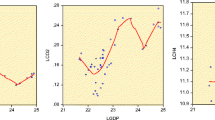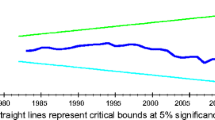Abstract
In the light of urban environmental transition (UET) theory, this study explores the relationship between carbon dioxide (CO2) emissions, economic growth, urbanization, and trade openness using updated Chinese data over the extended period (1971–2013). After confirming that all the underlying series are stationary and adjusted with single structural break point, the results of autoregressive distributed lag (ARDL) bounds test approach to cointegration confirm the cointegration between the variables. The long- and short-run dynamics reveal that urbanization reduces the CO2 emissions both in short and long runs, but statistically insignificant. These findings contrast with previous literature and sound the validation of urban environmental transition theory (UET). However, economic growth and trade openness contribute environmental degradation both in long- and short-run paths. The causality analysis reports bidirectional causal link between trade openness and urbanization in the short run. However, in the long-run, economic growth Granger causes carbon dioxide emissions, urbanization, and trade openness. Similarly, trade openness Granger causes carbon dioxide emissions, economic growth, and urbanization in the long run. The overall results imply that rural to urban immigration is still mostly driven by export-related manufacturing sectors. In addition, the higher GDP also contributes to urbanization as a feedback effect. In the end, stability of the model is also checked, model found stable, and findings are suitable for environmental policy control use.








Similar content being viewed by others
Notes
National Development and Reforms Commission (NDRC), 2011. http://en.ndrc.gov.cn/(Accessed:10.10.2015).
National Bureau of Statistics of China (NBSC), 2014. http://www.stats.gov.cn/enGLISH/PressRelease/201402/t20140224_515103.html (Accessed:10.10.2015).
For details, see Sadorsky (2014).
See for example the UK’s Environmental Policy (https://www.gov.uk/government/organisations/environment-agency)
See for example the European Union’s Environmental Action Programme(s) (http://ec.europa.eu/environment/archives/action-programme/)
World Bank’s WDIs. http://databank.worldbank.org/data/home.aspx (accessed March 9, 2015).
The unit root test has become the standard procedure and the literature is also well-established. Therefore, LP unit root test equations are not mentioned, but are available upon request.
Engle-Granger two-step residual-based method of cointegration developed in Engle and Granger (1987).
Johansen-Juselius maximum likelihood approach to cointegration developed in Johansen and Juselius (1990).
ECM is mainly used for cointegrated series, and their function is to estimate the speed at which a dependent variable return to its equilibrium position after a change occurs in an independent variable. ECM also helps to estimate the long- and short-run impacts between the series (for details, see Engle and Granger 1987; Banerjee et al. 1998).
Similarly, the number of test equations will be equal to the number of variables. However, we just mentioned single equation to conserve the space.
If the calculated F-statistics in column 4 of Table 4 lies above the upper bound I(1) value, the decision favors the rejection of null hypothesis and confirms the cointegration relationship. However, the value below the lower bound I(0) value and within the upper I(1) and lower I(0) bound values do not reject the null hypothesis (no cointegration relationship) and inconclusive relationship, respectively. For details, refer to Pesaran et al. (2001).
11th 5-year plan (2006–2010)
12th 5-year plan (2011–2015)
References
Abouie-Mehrizi M, Atashi SM, Elahi M (2012) The effects of variables population growth, urbanization and economic growth on CO2 emissions in Iran. Afr J Bus Manag 6(28):8414–8419
Ahmed K, Bhattacharya M, Qazi AQ, Long W (2016a) Energy consumption in China and underlying factors in a changing landscape: empirical evidence since the reform period. Renew Sust Energ Rev 58:224–234
Ahmed K, Shahbaz M, Kyophilavong P (2016b) Revisiting the emissions-energy-trade nexus: evidence from the newly industrializing countries. Environ Sci Pollut Res 23:7676–7691
Al-Mulali U, Solarin SA, Ozturk I (2016) Investigating the presence of the environmental Kuznets curve (EKC) hypothesis in Kenya: an autoregressive distributed lag (ARDL) approach. Nat Hazards 80(3):1729–1747
Banerjee AV (1992) A simple model of herd behavior. Q J Econ 107:797–817
Banerjee A, Dolado J, Mestre R (1998) Error‐correction mechanism tests for cointegration in a single‐equation framework. J Time Ser Anal 19(3):267–283
Brown RL, Durbin J, Evans JM (1975) Techniques for testing the consistency of regression relations over time. J R Stat Soc 37:149–192
Bryant, C. (2005). The impact of urbanisation on rural land. http://www.eolss.net
Cao B, Fu K, Wang S (2015) GMM-based research on environmental pollution and population migration in Anhui province, China. Ecol Indic 51:159–164
Cole MA, Neumayer E (2004) Examining the impact of demographic factors on air pollution. Popul Environ 26(1):5–21
Crenshaw EM, Jenkins JC (1996) Social structure and global climate change: Sociological propositions concerning the greenhouse effect. Sociol Focus 29(4):341–358
Dahl C, Erdogan M (1994) Oil demand in the developing world: lessons from the 1980s applied to the 1990s. Energy J 15:69–85
Development Research Center of the State Council, & The World Bank. (2014b). Urban China: toward efficient, inclusive, and sustainable urbanization. World Bank Publications
Dhakal S (2009) Urban energy use and carbon emissions from cities in China and policy implications. Energy Policy 37(11):4208–4219
Dickey DA, Fuller WA (1981) Likelihood ratio statistics for autoregressive time series with a unit root. Econometrica 49:1057–1072
Elliott GR, Thomas J, Stock JH (1996) Efficient tests for an autoregressive unit root. Econometrica 64:813–836
Engle RF, Granger CW (1987) Co-integration and error correction: representation, estimation, and testing. Econometrica 55:251–276
Fan Y, Liu LC, Wu G, Wei YM (2006) Analyzing impact factors of CO2 emissions using the STIRPAT model. Environ Impact Assess Rev 26(4):377–395
Gibbs D (2000) Ecological modernisation, regional economic development and regional development agencies. Geoforum 31(1):9–19
Gouldson A, Murphy J (1997) Ecological modernisation: restructuring industrial economies. The Political Quarterly, 68(B):74–86
Granger CW (1969) Investigating causal relations by econometric models and cross-spectral methods. Econometrica 37:424–438
Granger CW (1988) Some recent development in a concept of causality. J Econ 39(1):199–211
Halicioglu F (2007) Residential electricity demand dynamics in Turkey. Energy Econ 29(2):199–210
Hemmati H (ed) (2006) Deep space optical communications, vol 11. Wiley, Hoboken
Johansen S, Juselius K (1990) Maximum likelihood estimation and inference on cointegration with applications to the demand for money. Oxf Bull Econ Stat 52(2):169–210
Kalnay E, Cai M (2003) Impact of urbanization and land-use change on climate. Nature 423(6939):528–531
Karfakis C, Moschos D (1989) Testing for long run purchasing power parity: a time series analysis for the greek drachma. Econ Lett 30(3):245–248
Liddle B, Lung S (2010) Age-structure, urbanization, and climate change in developed countries: revisiting STIRPAT for disaggregated population and consumption-related environmental impacts. Popul Environ 31(5):317–343
Ling CH, Ahmed K, Muhamad RB, Shahbaz M (2015) Decomposing the trade-environment nexus for Malaysia: what do the technique, scale, composition, and comparative advantage effect indicate? Environ Sci Pollut Res 22(24):20131–20142
Lloyd-Jones T., & Rakodi C. (Eds.) (2014) Urban livelihoods: a people-centred approach to reducing poverty. Routledge
Lumsdaine RL, Papell DH (1997) Multiple trend breaks and the unit-root hypothesis. Rev Econ Stat 79(2):212–218
Ma H, Du J (2012) Influence of industrialization and urbanisation on China’s energy consumption. Adv Mater Res 524–527:3122–3128
Marcotullio, P. J. (2011) Socio-ecological systems and urban environmental transitions in the Asia pacific region. Population distribution, urbanization, internal migration and development: an international perspective, 205. Available at: https://www.wilsoncenter.org/event/socio-ecological-systems-and-urbanenvironmental-transitions-comparison-between-experiences
Marcotullio, P. J., & McGranahan, G. (2012) Scaling urban environmental challenges: from local to global and back. Earthscan. URL: https://books.google.de/books?id=-9jHG2uyRR8C&printsec=frontcover&source=gbs_ge_summary_r&cad=0#v=onepage&q&f=false
Marcotullio, P. J., Hughes, S., Sarzynski, A., Pincetl, S., Sanchez Peña, L., Romero‐Lankao, P., … & Seto, K. C. (2014) Urbanization and the carbon cycle: contributions from social science. Earth’s Future, 2(10), 496–514.
McGranahan G, Songsore J, Kjellén M (1996) Sustainability, poverty and urban environmental transitions. In: Sustainability, the environment and urbanization. Earthscan, London, pp 103–133
Mol AP, Spaargaren G (2000) Ecological modernisation theory in debate: a review. Environmental politics 9(1):17–49
Mol A. P., Spaargaren G., & Sonnenfeld D. A. (2013) Ecological modernization theory. Routledge international handbook of social and environmental change, 15
Narayan PK (2005a) The saving and investment nexus for China: evidence from cointegration tests. Appl Econ 37(17):1979–1990
Narayan PK, Popp S (2013) Size and power properties of structural break unit root tests. Appl Econ 45(6):721–728
National Bureau of Statistics of China (NBSC), 2014. Available at: http://www.stats.gov.cn/english/statisticaldata/AnnualData/
OECD (2013), “Urbanisation and green growth in China”, OECD regional development working papers, 2013/07, OECD Publishing. http://dx.doi.org/10.1787/5k49dv68n7jf-en
Perron P (1997) Further evidence on breaking trend functions in macroeconomic variables. J Econ 80(2):355–385
Pesaran MH, Shin Y, Smith RJ (2001) Bounds testing approaches to the analysis of level relationships. J Appl Econ 16(3):289–326
Phillips PC, Perron P (1988) Testing for a unit root in time series regression. Biometrika 75(2):335–346
Poumanyvong P, Kaneko S (2010) Does urbanization lead to less energy use and lower CO2 emissions? A cross-country analysis. Ecol Econ 70(2):434–444
Sadorsky P (2014) The effect of urbanization on CO 2 emissions in emerging economies. Energy Econ 41:147–153
Shahbaz M, Loganathan N, Muzaffar AT, Ahmed K, Jabran MA (2016) How urbanization affects CO2 emissions in Malaysia? The application of STIRPAT model. Renew Sust Energ Rev 57:83–93
Solarin SA (2014) Tourist arrivals and macroeconomic determinants of CO2 emissions in Malaysia. Anatolia 25(2):228–241
Solarin SA, Shahbaz M (2013) Trivariate causality between economic growth, urbanisation and electricity consumption in Angola: cointegration and causality analysis. Energy Policy 60:876–884
Spaargaren G, Mol AP (1992) Sociology, environment, and modernity: ecological modernization as a theory of social change. Soc Nat Resour 5(4):323–344
Sugar L, Kennedy C, Leman E (2014) Greehouse gas emissions from Chinese cities. J Ind Ecol 16(4):552–563
Vervoort, J. M., Thornton, P. K., Kristjanson, P., Förch, W., Ericksen, P. J., Kok, K., … & Jost, C. (2014) Challenges to scenario-guided adaptive action on food security under climate change. Global Environmental Change, 28:383–394
Wang Y, Zhao T (2015) Impacts of energy-related CO2 emissions: evidence from under developed, developing and highly developed regions in China. Ecol Indic 50:186–195
World Bank country overview, 2014a. Link: http://www.worldbank.org/en/country/china/overview (accessed 10.10.2015)
York R (2007) Demographic trends and energy consumption in European Union Nations, 1960–2025. Soc Sci Res 36(3):855–872
York R, Rosa EA, Dietz T (2003) STIRPAT, IPAT and ImPACT: analytic tools for unpacking the driving forces of environmental impacts. Ecol Econ 46(3):351–365
Zhang C, Lin Y (2012) Panel estimates for urbanisation, energy consumption and CO2 emissions: a regional analysis in China. Energy Policy 40:488–498
Zhao R, Huang X, Zhong T, Liu Y, Chuai X (2014) Carbon flow of urban system and its policy implications: the case of Nanjing. Renew Sust Energ Rev 33:589–601
Zivot E, Andrews DW (1992) Further evidence on the great crash, the oil-price shock, and the unit-root. J Bus Econ Stat 10:3
Zivot E, Andrews DWK (2002) Further evidence on the great crash, the oil-price shock, and the unit-root hypothesis. J Bus Econ Stat 20(1):25–44
Author information
Authors and Affiliations
Corresponding author
Additional information
Responsible editor: Philippe Garrigues
Rights and permissions
About this article
Cite this article
Ahmed, K. The sheer scale of China’s urban renewal and CO2 emissions: multiple structural breaks, long-run relationship, and short-run dynamics. Environ Sci Pollut Res 23, 16115–16126 (2016). https://doi.org/10.1007/s11356-016-6765-3
Received:
Accepted:
Published:
Issue Date:
DOI: https://doi.org/10.1007/s11356-016-6765-3




